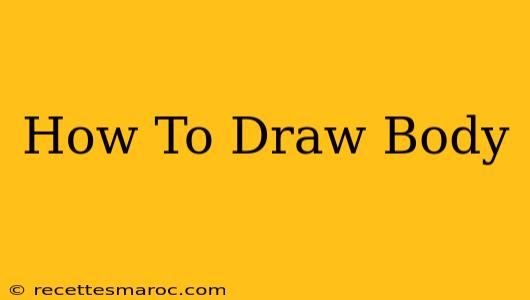Drawing the human body can seem daunting, but with practice and the right techniques, you can master this challenging yet rewarding skill. This guide will break down the process into manageable steps, perfect for beginners. We'll cover basic proportions, essential shapes, and helpful tips to improve your anatomical drawings.
Understanding Body Proportions
Before diving into details, grasping basic proportions is crucial. While individual variations exist, understanding average proportions provides a strong foundation. A common method uses the head as a unit of measurement:
- Head to Toe: The average adult human body is approximately seven to eight heads tall.
- Shoulder Width: Shoulder width is roughly two to three head widths.
- Hip Width: Hip width is generally slightly narrower than shoulder width.
- Leg Length: Legs are roughly four heads tall.
- Arm Length: Arms, when extended, usually reach the mid-thigh.
Remember, these are guidelines; artistic license allows for stylistic variations.
Breaking Down the Body into Simple Shapes
Instead of tackling complex details immediately, begin by constructing the body using basic geometric shapes:
- Head: An oval or circle.
- Torso: A slightly elongated oval or cylinder.
- Legs: Cylinders tapering slightly towards the ankles.
- Arms: Cylinders connected to the torso with shoulder and elbow joints.
- Hands and Feet: Simplified shapes like rectangles or flattened ovals.
This "skeleton" of simple shapes forms the foundation upon which you'll add detail. This method makes it easier to understand the underlying structure and proportions.
Constructing a Simple Pose: The "Mannequin" Method
- Start with a central vertical line: This represents the body's central axis.
- Add a horizontal line for the hips and shoulders: These help establish the body's overall posture.
- Sketch in the basic shapes: Use the simple shapes (ovals, cylinders, etc.) outlined above to build the body.
- Connect the shapes: Gently connect the shapes to create a rough outline of the figure.
- Refine the proportions: Adjust the shapes and lines until the proportions feel natural and balanced.
This "mannequin" approach simplifies the complex human form into manageable components. Don't worry about perfection at this stage; focus on getting the basic structure right.
Adding Details and Refining Your Drawing
Once you have a solid foundation, you can begin adding details:
- Musculature: Study anatomical references to understand the placement and form of major muscle groups. Begin with subtle suggestions of muscle definition rather than overly detailed rendering.
- Clothing: If drawing a clothed figure, consider how the fabric drapes and folds over the underlying body structure.
- Facial Features: Focus on capturing the unique features of your subject.
- Perspective: Consider the viewpoint of your drawing. The perspective will affect the appearance of body proportions and foreshortening.
Practicing and Improving Your Skills
Drawing the human body is a skill honed through consistent practice. Here are a few suggestions:
- Use References: Observe real people, photographs, and anatomical charts to study different poses and body types.
- Break it Down: Instead of attempting to draw a complete figure at once, focus on individual body parts (hands, feet, faces, etc.).
- Experiment with Different Media: Try different pencils, charcoal, or digital art tools to discover what works best for you.
- Seek Feedback: Share your work with others and ask for constructive criticism.
Mastering the art of drawing the human body is a journey, not a destination. With dedication and consistent effort, you'll gradually improve your skills and develop your unique style.

